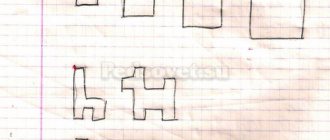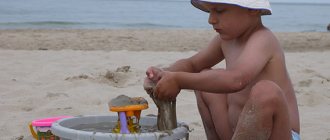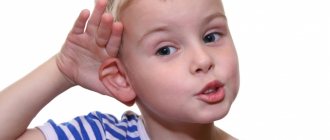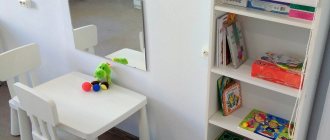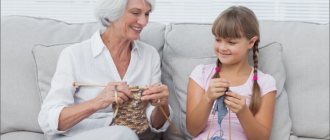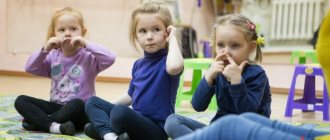What is fine motor skills and why is it so important? At what age to develop it? Useful exercises for the development of fine motor skills in children. How to develop it for adults. Signs of impairment How to restore: exercises, techniques
Good fine motor skills are not only dexterous hands and fingers, but also correct speech, beautiful handwriting, and also proper brain function. It must be practiced from a very early age in children, and not forgotten in adulthood; it is no less important for the elderly, so that speech and motor skills are not lost (this is especially true for those who have suffered a stroke).
The importance of skill!
The development of fine motor skills in children is the first key stage in the formation of mental abilities, precise, coordinated movements. The development of speech, dexterity, and intelligence depends precisely on how high the level of this skill is. It is closely and inextricably linked with vision, the nervous system, memory, attention, speech, and perception. Its stimulation allows you to activate processes in almost all areas of the brain, thereby accelerating the transmission of nerve impulses, improving blood circulation and tissue nutrition.
As a result, coordination (optical-spatial perception), speech, attention, thinking, imagination, observation, motor and visual memory develops.
Fine motor skills in children aged 1 year
Congratulations! Your baby is one year old! At this age, the child’s development is progressing by leaps and bounds, and he can already do a lot of things. Parents are usually impressed by gross motor skills, particularly the long-awaited first steps, but there is also something to be surprised about in the area of fine motor skills. Thanks to improved gross motor skills, the child is increasingly eager to explore the world around him. In the process, fine motor skills are also improved. The baby still cannot grasp the smallest objects, but this achievement is not far off. While your child enjoys exploring and playing with larger objects, such as wooden blocks and wooden puzzles. At this stage, significant progress occurs in the development of hand-eye coordination. Nowadays, the child increasingly uses one hand, but this does not mean that his leading hand has already been determined (that is, he will be left-handed or right-handed).
How to develop hand motor skills in a child aged 1 year
As your child gets older, you can do the following exercises to develop hand motor skills:
- Show your child how to fold paper. You can make an accordion fan or a paper airplane with it.
- Have your child insert different shaped blocks or pegs (square, rectangular, triangular) into the corresponding holes.
- Show him how to stack the blocks on top of each other to make a tower.
- Offer him toys that can be taken apart and put together safely, such as a set of cups that nest inside each other.
- Invite him to sculpt something from plasticine.
- Entrust him with simple housework, such as sweeping, arranging items, or helping you prepare food (stirring pancake batter or putting vegetables in a pan).
- Play together outside, for example, you can throw a ball to each other.
Summarize
| Between the ages of 1 and 2 years, a child develops the following skills and abilities: ● He can build a tower from blocks and immediately break it. ● He plays with boxes, containers and their lids. ● He can lift a moving object, such as a ball. ● He leafs through books. ● He turns the door handles. ● It knows how to insert pins into the corresponding holes. ● He draws with pencils or fingers. ● He knows how to drink from a mug. ● He can feed himself with a spoon (with varying degrees of success). |
Speech and fingers are interconnected!
The development of fine motor skills in children is the most important stage that determines how quickly and correctly the formation of speech skills will occur. The fact is that the brain centers responsible for speech and finger movement are located in close proximity to each other. In the course of electrophysiological studies, scientists from different countries found that when a child performs rhythmic movements of the fingers, the activity of certain parts of the brain is sharply activated - the motor speech zone, the sensory (temporal) zone, that is, under the influence of impulses coming from the fingers, speech patterns are formed areas.
Modeling is a great activity for developing a child's fine motor skills.
Parents are required not only to surround the child with attention, care, and provide everything necessary for a happy childhood, but also to take an active part in all processes of his development.
The first and main step is to develop a high level of fine motor skills. It develops from birth, initially the baby learns to control its hands and perform simple gestures, for example, grasping a rattle with the entire palm. Then he learns to control his fingers, taking the toy with his index finger and thumb. At first the movements are awkward and inharmonious. Stimulating this skill is a gradual and individual process; it proceeds differently for everyone. But, if it is not active, then the development of speech, coordination, dexterity, memory, attention, and intelligence will slow down.
What are fine motor skills and why are they so important?
This is a complex of coordinated actions and movements of the arms, fingers, and legs. This is not just motor activity, because all movements of the limbs occur under the control of the brain and are directly related to its work.
Fine motor skills combine processes in the motor, nervous, and visual systems.
Benefit
- Since several systems of the body are involved in the process of activity, the development of fine motor skills literally mobilizes the whole body, developing them all together and separately.
- The work of several parts of the brain at once contributes to its development, rapid processing of information, and the formation of new connections between neurons.
- The nerve endings on the palms and feet are connected to parts of the body and organs, which means that the impact (via nerve impulses) occurs on them. The muscles of the limbs and fingers develop, dexterity and activity of the arms and legs accelerate, handwriting becomes clearer and better.
- Speech development occurs because the areas in the brain responsible for movement and speech are very close. Fine motor skills exercises are necessary for children who are still learning to speak, and for older people, in whom this skill may be impaired due to serious illnesses, especially stroke. According to statistics, impairment of motor function after strokes occurs in 70% of cases, and in 50% it does not recover even after six months. In such a situation, it is very important to exercise regularly.
- Memory improves. This happens due to increased brain activity.
- Imagination and creativity develops. It has been proven that working with real visual images improves spatial thinking, the ability to imagine something fictitious, and come up with non-standard solutions to problems.
- The ability to clearly plan actions develops. According to one theory, the development of fine motor skills teaches the brain to think through its actions before performing it and to do it very quickly.
Do not miss
- Do not miss
5 simple brain must-haves to maintain intelligence for a long time
The most common exercises and games
Finger gymnastics
The most effective exercises for sensorimotor development in children from 5 months to 1.5 years are those that take place in a fun and interesting way for his age.
- The fingers say hello - each finger in turn touches its fellow opposite.
- The fun and well-known massage game “Magpie Crow Cooked Porridge” works great, as does the game “Ladushki”.
- Playing the piano - we randomly raise our fingers from the surface one at a time or all together.
- Draw circles and figure eights in the air with each finger.
- Tearing paper (suitable for children from 7 months). Give your baby two sheets of colored paper, he will be happy to examine them, feel them, and begin to crumple and tear them.
40 games to develop fine motor skills.
For older children
- Turning the pages of a picture book.
- Beads - sorting through small objects is very useful. Put on necklaces with different sized beads, he will really like to finger them.
- Insert games (bowls, pyramids, etc.) They can be nested inside each other to build towers. This game is very interesting for kids and develops the concept of the size of objects.
For children from 3 years old
Games with small objects (beads, buttons, pebbles, cereals)
Such games are played only under adult supervision. They have a comprehensive effect - developing, calming, tonic, healing. Excellent for developing motor skills and tactile sensations. Pour any cereal into a bowl and give it to your child. He will be happy to touch her, to let her slip through his fingers.
Offer to separate the pre-mixed beans and peas, or look for pebbles in the cereal. Set the task of drawing a sun or any other simple drawing on white cardboard. Exercises with tweezers or forceps work well for developing motor skills. Show how you can transfer objects using such a tool and ask him to transfer peas, pebbles or beads into a bottle with a narrow neck.
Special games for developing fine motor skills.
It is very useful and interesting for children to string beads/buttons on a thread, and this can be done not only in any form, but also to complicate the task by suggesting a certain stringing sequence. Don't forget about mosaic games.
Finger games are an effective way to develop fine motor skills.
They present a dramatization of some stories or fairy tales. You can paint bottle caps, put light cubes with holes on your fingers, or buy special finger puppets. Children are interested in playing such games from one year to primary school age. Finger games involve the use of both hands. To obtain the greatest results, these exercises must be structured so that tension and relaxation, squeezing and unclenching are constantly changing in the hands.
Screwing, fastening, unfastening
Screwing and unscrewing the lids of any vessels (preferably those of different shapes and sizes) perfectly develops finger dexterity. Fastening/unfastening buttons, zippers, lacing - develops motor skills, concentration and teaches independence. Therefore, be sure to ask your child to join in the dressing process.
A special toy poster for children, you can make it yourself.
Modeling develops motor skills and imagination
Here it is important to work with different materials: plasticine, clay, plastic dough. Moreover, the sculpting process must take place in a new form each time. For example, with plasticine you can not only sculpt something, but also paste it over bottles, thereby giving a new shape to some object (jug, vase, etc.). Lay out on cardboard with plasticine balls, strips, a specific design.
Using clay, it is useful and fun to make handprints, fingerprints, fingerprints, or make prints of foreign objects. Modeling is very exciting for children of any age and does not limit their imagination.
Play with sand
They help not only in the development of sensorimotor skills, but also in unlocking creative potential, and also calm the nervous system. You can draw various shapes on the flat sand with your finger, hide a lot of small toys in it and find them, you can set the task of pouring a certain number of piles of sand, etc.
Playing with sand or small grains is a great way to develop fine motor skills in children.
The best exercises in the complex
There is no need to buy exercise equipment, sportswear and other traditional attributes. To perform the exercises you will need different, but absolutely simple objects. Most of them are in every home, from buttons to pine cones, pebbles and shells, once brought from the sea.
After preparation, you can safely proceed to the complex. The result will not take long to arrive.
Exercises without objects
- We fold our palms and actively, intensively rub them together. As a result, you should feel warm.
- Place the palm of each hand on a hard, flat surface. In turn, slowly, raise each finger up. The palm should remain pressed. If there are no suitable surfaces nearby, you can put your hands on your stomach.
- Using the fingers of one hand, we carefully make pinching movements in relation to the other limb. Then we change “roles”.
- Using the pad of the thumb, we alternately touch the other fingers on the hand, thus forming rings.
- We squeeze and unclench the palms of each hand. We do this one by one.
Interesting fact. In fact, there are a huge number of exercises, as well as ways to develop fine motor skills in general. If such simple elements are not enough, get creative. Modeling from plasticine, drawing with crayons, massages, embroidery, knitting - this and much more also contributes very well to development.
Exercises with objects
- We take small nuts or a cone in our hands. We squeeze them tightly enough with our palms. And then we transfer it from one hand to the other.
- Take a long ribbon or thick thread and large beads. Gradually we string one on top of the other - we make beads. After this, we disassemble the resulting “construction”.
- Pour different types of cereals into a deep bowl. Mix them. After this we perform sorting. Distribute the grains among several plates.
- Take a small rubber ball, maybe with pimples/spikes (this is even better). Roll it on a flat, hard surface with your palms one at a time.
- Pour small grains into a bowl. We try to move it in small portions using our hands to another dish.
- We ask your loved one to select several items of different sizes and textures. We close our eyes and try to recognize each of them by touch. Ceramic products, soft toys, figurines, cutlery, etc. are suitable.
Fine motor skills in children aged 4 years
A child at 4 years old is already quite big, and the development of hand motor skills is almost complete.
How to develop hand motor skills in a child aged 4 years
Around this time, the child begins to be interested in artistic creativity, complex games and other activities that require manual dexterity. For example, he may be interested in the following activities:
- Draw full-length human figures with arms, legs and face.
- Write block and capital letters.
- Draw, trace and sketch geometric shapes.
- Draw with paint and fingers.
- Sculpt figures from plasticine.
- Cut out complex shapes from paper using children's scissors.
- Play with blocks and use them to build tall or massive structures, such as a tower or fortress.
- Play cards or board games.
Summarize
| At the age of 4 years, a child usually develops the following skills: ● He knows how to brush his teeth independently under the guidance of his mother. ● He dresses independently with virtually no help from his mother. ● He knows how to tie his shoelaces. ● He has no problem using cutlery, even a knife. ● He goes to the toilet on his own and takes care of himself. |



